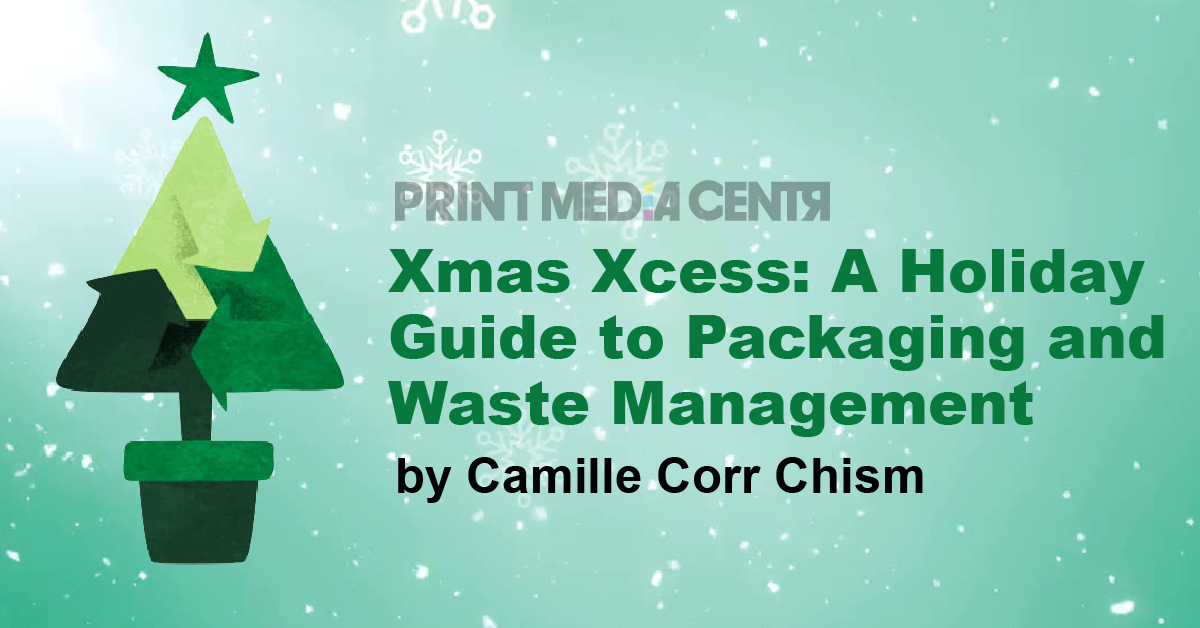
People are very conscientious about recycling packaging & waste on a daily basis, why not keep the momentum of sustainability going during this season of festivities?
Think of the complete lifecycle, from beginning to end as you make holiday decisions and keep sustainability in mind. There are many actions you can take while going to events and gatherings, shopping more, and cooking more which generates more opportunities for sustainable living (e.g. more waste).
While this is a packaging blog, let’s first address the elephant in the room. What says ‘holiday season’ more than a well-lit tree?
No matter what holiday you celebrate this time of the year, it’s hard to resist the temptation of decorating your home with some form of greenery. While both live and artificial trees have pros and cons, the key is waste reduction, learn more on the American Christmas Tree Association (ACTA) website.
In addition to the typical lively discussions about football games, who makes the best casserole, or who should win the Ugly Sweater Contest this year, ask which is more sustainable – live or artificial trees. Approximately 20 to 40 million Christmas trees are cut down annually in the US, decorated, displayed, and discarded by consumers in the United States alone, according to ACTA.
Below is a list of packaging and related holiday items consumed more this time of year, followed up with recommendations on which of the 4Rs (Reduce, Reuse, Recycle, or Repurpose) fit best for selecting and handling.
Christmas Trees & Greenery
Consider this chart as you decide on holiday greenery.
| Team Live | Team Artificial | Team No Tree | |
| Carbon Footprint | Negligible | Negligible | 0 |
| End of Life Potential | Incineration or Landfill | Landfill | N/A |
| Recycle/Upcycle | Mulch or plant | Donate | N/A |
| Usage | 20,000,000 | 75,000,000 | 0 |
| Lifespan | 1-3 months | 10 years | N/A |
| Origin of Tree | Local | International | N/A |
TOSS UP – the choice of tree is yours, be conscious of the impact for use and end of life.
Always pay attention to the packaging, materials, and decorations (wraps, bags, boxes, artificial snow, ornaments, garland, etc.).
Recommended: REDUCE, REUSE, RECYCLE AND REPURPOSE
Packaging from gifts, products, and corrugated shippers pile up this time of year. If you ship during the holidays, look for packaging and gifts with recycled or sustainable materials.
Recommended: REDUCE, REUSE, AND RECYCLE
Cups, plates, and utensils allow for easy clean-up. Do you dump used paper and plastic upcycle any of these items? Are compostable items an option? Do you know what gets recycled in your area?
Recommended: REDUCE AND REPURPOSE
Wine, beer, and champagne bottles are popular on New Year’s Eve. At least 90 MILLION bottles of champagne will be consumed as the new year unfolds!
Recommended: REDUCE, RECYCLE, AND REPURPOSE
Paper gift bags and wrapping are often coated with foil or plastic and the mix of materials cannot be recycled and damage recycling equipment.
Recommended: REDUCE and REUSE
Foam cups are great to insulate coffee and festive hot chocolate to keep drinks toasty warm. This material is recyclable if your state hasn’t banned the material. Check to see if your local recycler processes or landfills them.
Recommended: REDUCE and RECYCLE
Styrofoam cushions protect electronics in shipment, see if they get recycled near you.
Recommended: REDUCE and RECYCLE
Plastic grocery bags go along with more groceries for large meals, opt for reusable or paper bags if recycling plastic bags is not an option. Take note of extra packaging for gifts, trees, lights, food, and gatherings – boxes, bags, bottles, cartons, pallets, etc.
REDUCE, REUSE, RECYCLE, REPURPOSE
Consider This
Other items consumed during the season impact the environment, make a conscious decision to make a positive impact on the health of our planet.
- Plastic decorations and toys – when possible, select products with recycled content or make them out of found objects
- Electricity – how much do holiday lights add to the electric bill
- Light pollution – outdoor lighting changes sleep patterns and ultimately the health of humans and animals
- Travel – the increased use of planes, trains, and automobiles impacts the carbon footprint
- Water – check your water bill, does it increase due to watering more plants, cooking, cleaning, etc.
What other ideas do you have?
As always, I love to hear your feedback, thoughts & comments. Do you already practice any of these practices and are there any you plan to adopt for this and future holiday seasons?
Most importantly, remember this time of year is joyous, take time to enjoy your holiday season!
 Camille Corr Chism, CPPL Fellow, has a diverse background in packaging engineering, design, supply chain, project management, and new product introductions. Her experience includes a variety of industries including food, e-commerce, technology, distribution, pharmaceutical, industrial, and automotive. Earning an MS and BS in Packaging, Camille earned a Six Sigma Black Belt (2019), and a lifetime certification as a Certified Packaging Professional in 2006. She was inducted into the IoPP College of Fellows in 2014.
Camille Corr Chism, CPPL Fellow, has a diverse background in packaging engineering, design, supply chain, project management, and new product introductions. Her experience includes a variety of industries including food, e-commerce, technology, distribution, pharmaceutical, industrial, and automotive. Earning an MS and BS in Packaging, Camille earned a Six Sigma Black Belt (2019), and a lifetime certification as a Certified Packaging Professional in 2006. She was inducted into the IoPP College of Fellows in 2014.
Camille is the owner of Indigo Packaging and Consulting. She is the go-to person for all your packaging products and packaging design needs. Connect with her on LinkedIn, LinkedIn Company Page, Twitter @indigopkg, and Instagram @indigopkg











